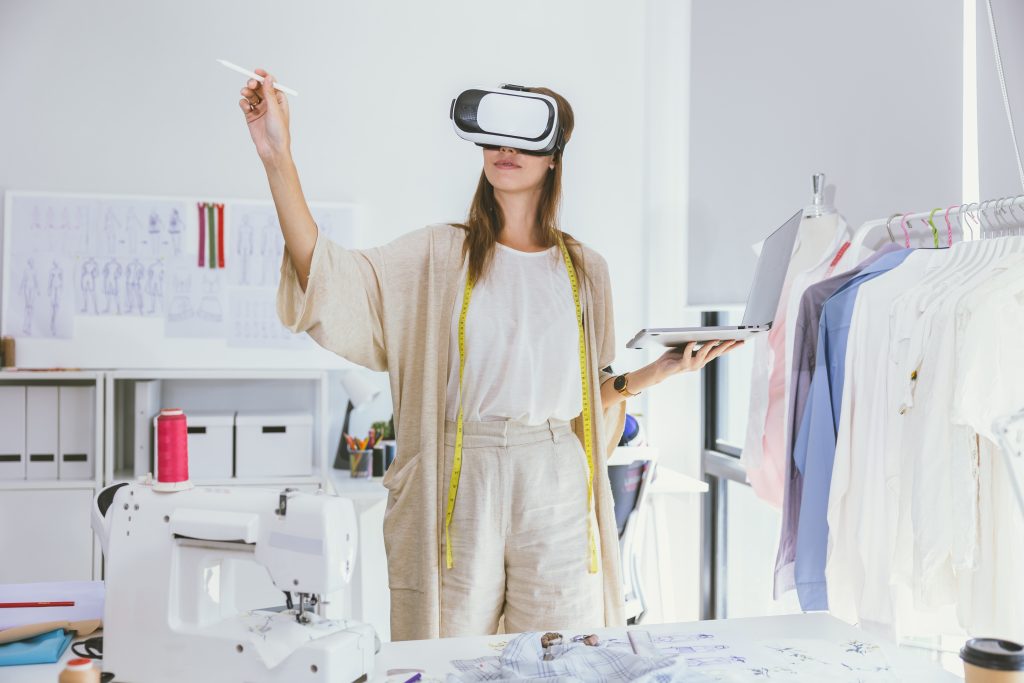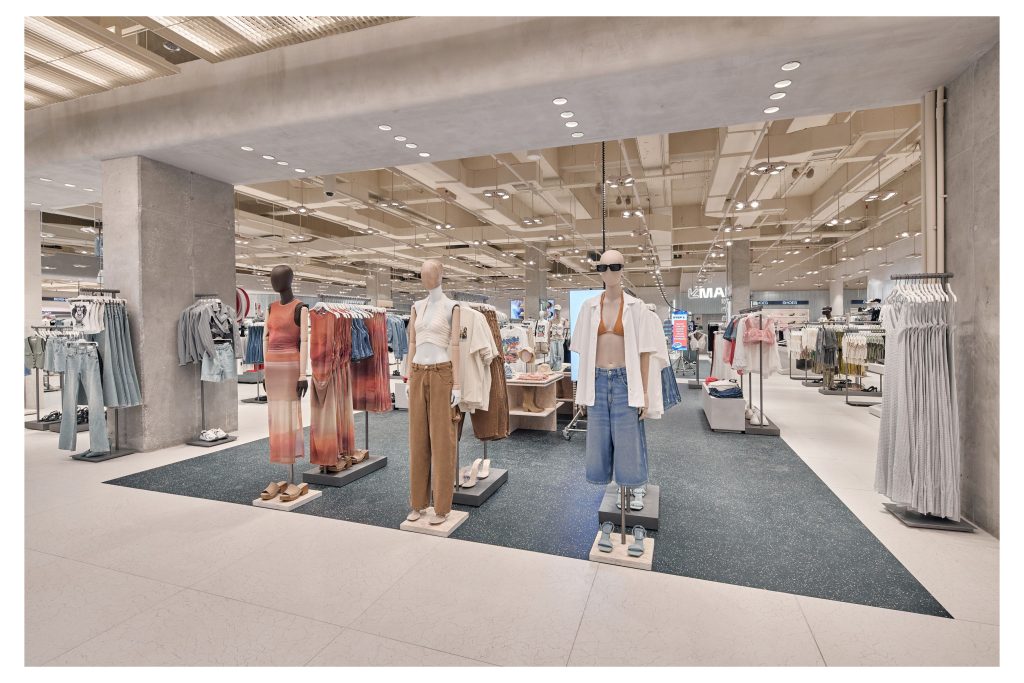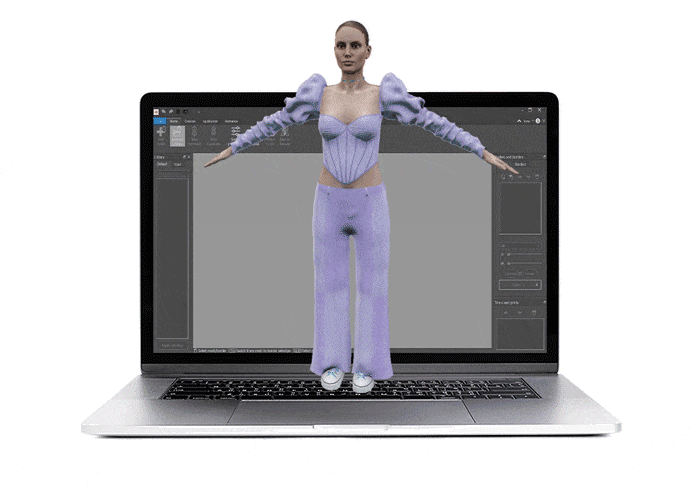Summary:
- Augmented reality has the potential to transform the fashion experience, offering unprecedented creative and expressive possibilities;
- Various applications of augmented reality are emerging, including virtual fashion in the metaverse, fashion integration in video games, NFTs, and the utilization of artificial intelligence;
- Explore the boundless opportunities of the fashion of the future by trying out Audaces360 multi-solution for free today!
When we talk about augmented reality, we are referring to an experience that bridges the gap between physical reality and computer-mediated reality.
This technology enhances human sensory perception by providing electronically generated information that would otherwise be imperceptible to our five senses.
Typically, augmented reality experiences occur through the use of mobile devices. Individuals continue to engage with the physical environment while simultaneously receiving additional information that enriches their reality.
The evolution of technology in this field, particularly during the years of the pandemic, has brought augmented reality to the forefront, even in the fashion industry. It has become increasingly central in shaping future scenarios.
Sumário
If you are intrigued by this topic and would like to explore how augmented reality can influence the fashion market and enhance the fashion experience, read on!
What is augmented reality in fashion?

Augmented reality made its debut in the fashion world back in 2012 when Diane Von Furstenberg showcased the first Google Glass on the runway.
Since then, the sector has witnessed significant advancements, including introducing viewers and Oculus devices, culminating in Apple’s Vision Pro, unveiled this year.
These innovative instruments have shifted the focus from the physical world to the virtual realm, allowing us to envision fashion and its market in an immaterial dimension.
The growing number of collaborations between augmented reality and the fashion and luxury industries suggests that this trend will continue to gain momentum in the near future. What are your thoughts on this?
Here are a few current examples of augmented reality applications in the world of fashion:
Virtual fashion in the metaverse
In 2023, Decentraland successfully hosted its second Metaverse Fashion Week, a week-long virtual fashion event centered around the theme of “Future Heritage.” The event showcased the exciting possibilities of fashion within the digital realm.
Meanwhile, Roblox has partnered with renowned fashion brands such as Gucci and Burberry to create virtual stores. Users can now acquire virtual luxury items, ranging from clothing to bags, shoes to hats. Avatars in the metaverse can now boast an envy-inducing wardrobe that rivals those of prominent celebrities.
The emergence of virtual fashion in the metaverse is revolutionizing the way we interact with and express ourselves through clothing and style. It presents a unique opportunity to explore limitless creativity and personalization in the digital fashion landscape.
Learn more: Find out how fast fashion and sustainability can coexist in the apparel industry
Fashion and videogames
The collaboration between fashion and video games is an ever-expanding frontier. It goes beyond the boundaries of digital capsule collections designed for avatars and extends into the real world.
These collaborative experiences provide a platform for fashion houses and video games to share values and imaginations, offering new possibilities to express brand identities and engage with users.
The fusion of fashion and video games not only showcases innovative designs but also facilitates a unique form of self-expression, blurring the lines between virtual and physical realms.
In this dynamic realm, fashion becomes a powerful medium for storytelling and allows users to immerse themselves in a world where style and gaming intersect.

NFTs
NFTs (Non-Fungible Tokens) hold immense potential for the fashion market. In recent years, brands have begun to recognize the value of creating unique digital assets, such as original designs or artworks, protected by blockchain technology.
This innovative system enables the creation of an economy centered around intangible goods, such as virtual dresses or bags, mirroring the exclusivity found in the physical world.
By leveraging NFTs, fashion brands can establish a new paradigm for ownership and authenticity, while fostering a digital marketplace for fashion enthusiasts. This emerging trend opens up exciting possibilities for the intersection of fashion, technology, and blockchain.
Learn more: How to drive business growth in fashion with NFTs
Intelligence Artificial
Artificial Intelligence (AI) has proven to be a valuable tool in the fashion industry. Initially employed for logistics and process management, AI is now increasingly recognized for its creative capabilities.
Consider the example of a stylish outfit generated entirely through AI, such as a person wearing a Moncler down jacket. This AI-generated image sparked significant discussion and debate, highlighting the potential impact of AI in fashion.
Similar to other domains, the question arises: Will AI eventually replace human creativity in fashion? At present, it is difficult to predict.
However, it is more likely that we will witness an integration of human intelligence and Artificial Intelligence, working together to push the boundaries of fashion innovation.
AI can assist in tasks such as trend analysis, personalized recommendations, and even fabric design. By harnessing the power of AI, fashion industry professionals can enhance their creativity, streamline processes, and offer unique experiences to customers.
The future of AI in fashion holds immense potential for collaboration and synergy between machine and human expertise.
Learn more: Find out how futuristic fashion is revolutionizing the industry with technology
How to leverage augmented reality in your fashion business?
As we have seen, augmented reality offers numerous opportunities for exploration within the fashion industry. Here are a few ways you can utilize augmented reality in your fashion business:
- Connecting with new audiences: Augmented reality provides a platform to engage with new and younger demographics, creating interactive experiences that captivate their attention.
- Expressing values and aesthetics: Utilize augmented reality to showcase your brand’s values and aesthetics through new visual languages, enabling a deeper connection with your target audience.
- Targeted data insights: Augmented reality experiences can track user activity, providing valuable data that can be used to improve targeting strategies, thanks to artificial intelligence.
If you’re considering venturing into this realm with your clothing manufacturing, one strategy could be to launch a new product in the metaverse in collaboration with a physical event.
This approach presents an opportunity to expand your market and establish a niche position.
Alternatively, you could explore the creation of a collection of NFTs, drawing inspiration from notable brands like Gucci. Imagine the global reach and impact your creations could achieve in this exciting digital space.
Learn more: How does technology in fashion impact the textile industry?
Advantages of using augmented reality in fashion production

If you’re still unsure about the relevance of augmented reality in the future of fashion, let’s explore some present-day advantages that highlight its potential.
It’s important to note that these technologies are continually evolving, so the applications are poised to multiply soon!
Convenient size and fit advisor for clothing
With the surge in online shopping, especially during and after the pandemic, the total value of e-commerce purchases in Italy alone reached 48.1 billion euros in 2022, a 20% increase compared to 2021.
If you’ve ever made online purchases, you’re likely familiar with the challenge of visualizing how a garment will fit your body beyond simply choosing the right size.
This difficulty often leads to a high rate of returns, impacting both the customer experience and incurring significant costs and environmental pollution.
The next evolution in augmented reality technology for the fashion industry is virtual try-on. This innovative technology allows anyone to try on a product regardless of their location or physical attributes.
Leading brands such as Gucci and Prada have already integrated virtual try-on services for accessories on their e-commerce platforms. This year, Valentino, through the app Wanna Wear, takes it a step further by enabling users to virtually try on clothes from their Fall/Winter 2023 collection.
By leveraging a size and fit advisor, fashion brands not only benefit customers but also contributes to a more sustainable and efficient fashion industry.

Engaging consumer interactions
Augmented reality opens up new and unprecedented avenues for interacting with consumers, including through the use of smart mirrors. Beyond simple virtual fitting rooms, smart mirrors are increasingly utilized in the fashion and beauty sectors for visual merchandising and advertising purposes.
They offer the added value of generating user-generated content, leading to free promotion and increased engagement.
A recent example of such interaction can be seen in Coach’s collaboration with the augmented reality platform ZERO10 during the launch of the Tabby Bag.
Customers visiting the Coach store in Soho, New York, had the opportunity to try digital versions of the bag on smart mirrors and share their looks on social media. This innovative approach blended physical and digital experiences, fostering unique interactions with consumers.
Another exciting example is DressX, the largest digital fashion platform, which enables users to virtually wear clothing within a digital space.
Simply select a garment and submit your photo, and within three days, you’ll receive an image of yourself wearing the chosen item. This image can be shared on social media, generating unprecedented interactions and conversations.
Minimized raw material waste
Did you know that the world produces 92 million tons of textile waste every year? Now, imagine an industry where physical garments are not produced, leading to a 97% reduction in CO2 emissions and saving 3,300 liters of water per item.
Digital fashion offers a promising solution to the environmental challenges posed by traditional production chains.
Since digital fashion exists purely in virtual form, it is inherently sustainable, minimizing its environmental impact. To achieve full sustainability, all that is required is for clothing producers to use clean and renewable energy sources.
For physical clothing brands, computer-aided creation, and approval processes eliminate fabric waste and reduce the need for raw material development. By designing and approving clothing virtually, brands can significantly reduce the consumption of resources such as fabric and other raw materials.
Learn more: All you need to know about sustainable fashion jobs and Industry 5.0
Explore your collections in augmented reality with Audaces Fashion Studio

Audaces Fashion Studio is a powerful fashion design software utilized by industry professionals to create and develop clothing and accessories.
It serves as a crucial tool in the development of physical collections, saving time and raw materials in the prototyping process, while also acting as a starting point for the creation of digital designs.
The software offers a range of features designed to streamline the design process, including:
- Fabric wearability simulation, allowing users to visualize how garments will behave before physical production.
- Application of colors, prints, and realistic textures to ensure a faithful representation of the design.
- Reduction of prototypes during the creation phase, resulting in significant time and resource savings.
- Efficient communication between style and modeling teams to minimize errors and rework.
- Clear and realistic display of models directly on the computer, enabling precise adjustments.
- And much more!
With Audaces Fashion Studio, you can create high-resolution patterns with intricate details, and even transform them into NFTs while preserving their digital quality.
If you want to stay ahead of fashion trends and prepare to meet the demands of the future, download our comprehensive e-book for free. It delves into the latest trends and provides you with the knowledge to navigate the evolving metaverse landscape:
FAQ
Augmented reality in fashion refers to the integration of virtual elements into the real world, allowing for the creation, try-on, and wearing of virtual garments in innovative and previously unexplored ways.
There are various ways to leverage augmented reality in the fashion industry. For example, you can create your next collection virtually and showcase it in the metaverse, or you can develop a collection of unique NFTs that blur the boundaries between physical and digital fashion.
Firstly, it provides an easy and immersive way for customers to try on virtual garments. Secondly, it enables interactive experiences that allow for enhanced consumer engagement. Lastly, it contributes to a significant reduction in the waste of raw materials.










